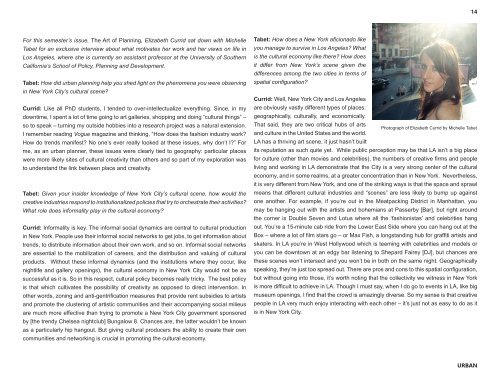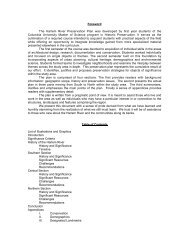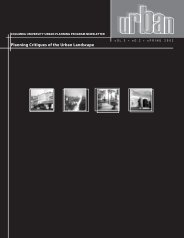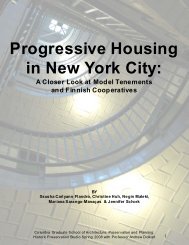The Art of Planning - Columbia University Graduate School of ...
The Art of Planning - Columbia University Graduate School of ...
The Art of Planning - Columbia University Graduate School of ...
You also want an ePaper? Increase the reach of your titles
YUMPU automatically turns print PDFs into web optimized ePapers that Google loves.
14<br />
For this semester’s issue, <strong>The</strong> <strong>Art</strong> <strong>of</strong> <strong>Planning</strong>, Elizabeth Currid sat down with Michelle<br />
Tabet for an exclusive interview about what motivates her work and her views on life in<br />
Los Angeles, where she is currently an assistant pr<strong>of</strong>essor at the <strong>University</strong> <strong>of</strong> Southern<br />
California’s <strong>School</strong> <strong>of</strong> Policy, <strong>Planning</strong> and Development.<br />
Tabet: How did urban planning help you shed light on the phenomena you were observing<br />
in New York City’s cultural scene?<br />
Currid: Like all PhD students, I tended to over-intellectualize everything. Since, in my<br />
downtime, I spent a lot <strong>of</strong> time going to art galleries, shopping and doing “cultural things” –<br />
so to speak – turning my outside hobbies into a research project was a natural extension.<br />
I remember reading Vogue magazine and thinking, “How does the fashion industry work?<br />
How do trends manifest? No one’s ever really looked at these issues, why don’t I?” For<br />
me, as an urban planner, these issues were clearly tied to geography: particular places<br />
were more likely sites <strong>of</strong> cultural creativity than others and so part <strong>of</strong> my exploration was<br />
to understand the link between place and creativity.<br />
Tabet: Given your insider knowledge <strong>of</strong> New York City’s cultural scene, how would the<br />
creative industries respond to institutionalized policies that try to orchestrate their activities?<br />
What role does informality play in the cultural economy?<br />
Currid: Informality is key. <strong>The</strong> informal social dynamics are central to cultural production<br />
in New York. People use their informal social networks to get jobs, to get information about<br />
trends, to distribute information about their own work, and so on. Informal social networks<br />
are essential to the mobilization <strong>of</strong> careers, and the distribution and valuing <strong>of</strong> cultural<br />
products. Without these informal dynamics (and the institutions where they occur, like<br />
nightlife and gallery openings), the cultural economy in New York City would not be as<br />
successful as it is. So in this respect, cultural policy becomes really tricky. <strong>The</strong> best policy<br />
is that which cultivates the possibility <strong>of</strong> creativity as opposed to direct intervention. In<br />
other words, zoning and anti-gentrification measures that provide rent subsidies to artists<br />
and promote the clustering <strong>of</strong> artistic communities and their accompanying social milieus<br />
are much more effective than trying to promote a New York City government sponsored<br />
by [the trendy Chelsea nightclub] Bungalow 8. Chances are, the latter wouldn’t be known<br />
as a particularly hip hangout. But giving cultural producers the ability to create their own<br />
communities and networking is crucial in promoting the cultural economy.<br />
Tabet: How does a New York aficionado like<br />
you manage to survive in Los Angeles? What<br />
is the cultural economy like there? How does<br />
it differ from New York’s scene given the<br />
differences among the two cities in terms <strong>of</strong><br />
spatial configuration?<br />
Currid: Well, New York City and Los Angeles<br />
are obviously vastly different types <strong>of</strong> places:<br />
geographically, culturally, and economically.<br />
That said, they are two critical hubs <strong>of</strong> arts<br />
Photograph <strong>of</strong> Elizabeth Currid by Michelle Tabet<br />
and culture in the United States and the world.<br />
LA has a thriving art scene, it just hasn’t built<br />
its reputation as such quite yet. While public perception may be that LA isn’t a big place<br />
for culture (other than movies and celebrities), the numbers <strong>of</strong> creative firms and people<br />
living and working in LA demonstrate that the City is a very strong center <strong>of</strong> the cultural<br />
economy, and in some realms, at a greater concentration than in New York. Nevertheless,<br />
it is very different from New York, and one <strong>of</strong> the striking ways is that the space and sprawl<br />
means that different cultural industries and “scenes” are less likely to bump up against<br />
one another. For example, if you’re out in the Meatpacking District in Manhattan, you<br />
may be hanging out with the artists and bohemians at Passerby [Bar], but right around<br />
the corner is Double Seven and Lotus where all the ‘fashionistas’ and celebrities hang<br />
out. You’re a 15-minute cab ride from the Lower East Side where you can hang out at the<br />
Box – where a lot <strong>of</strong> film stars go – or Max Fish, a longstanding hub for graffiti artists and<br />
skaters. In LA you’re in West Hollywood which is teeming with celebrities and models or<br />
you can be downtown at an edgy bar listening to Shepard Fairey [DJ], but chances are<br />
these scenes won’t intersect and you won’t be in both on the same night. Geographically<br />
speaking, they’re just too spread out. <strong>The</strong>re are pros and cons to this spatial configuration,<br />
but without going into those, it’s worth noting that the collectivity we witness in New York<br />
is more difficult to achieve in LA. Though I must say, when I do go to events in LA, like big<br />
museum openings, I find that the crowd is amazingly diverse. So my sense is that creative<br />
people in LA very much enjoy interacting with each other – it’s just not as easy to do as it<br />
is in New York City.<br />
URBAN
















